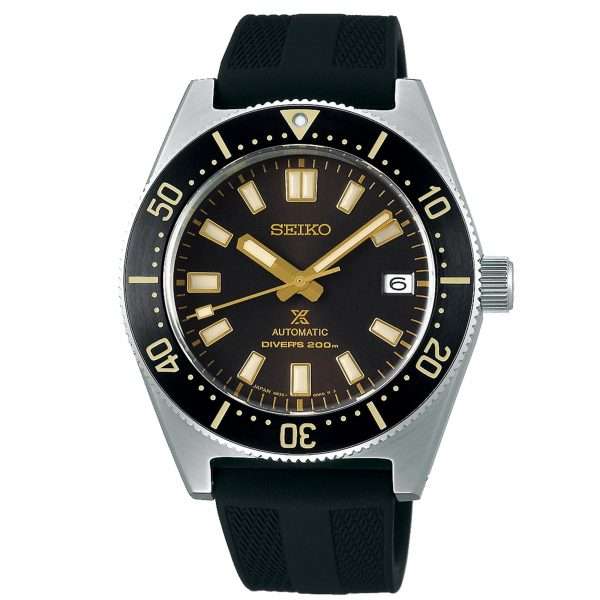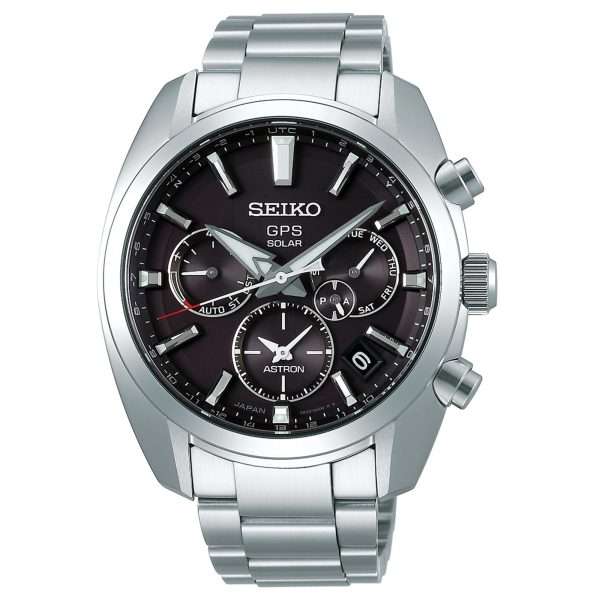Seiko’s Legacy of Innovation: From the Seiko Laurel to the Astron GPS Solar
Seiko is an abbreviation of “Seikosha,” which roughly translates to, “House of Exquisite Workmanship” in Japanese. This name is not just a title; it’s a guiding principle that defines Seiko’s commitment to excellence. Since its inception in 1881, Seiko has continually pushed boundaries, establishing itself as a watchmaking pioneer in Japan and a globally renowned brand that embodies the spirit of innovation and precision.
As we celebrate the 110th Anniversary of the Laurel, Japan’s first wristwatch, let’s also take a closer look at some of Seiko’s other most seminal timepieces.
The Seiko Laurel: Pioneering Japan’s Wristwatch Revolution (1913)

It began in 1913 when Seiko introduced the Seiko Laurel, Japan’s first wristwatch. This momentous release marked the beginning of Seiko’s illustrious journey into wrist watch manufacturing. It was a timepiece that not only told the time but also told a story of ambition and innovation. This watch laid the foundation for Seiko’s future as a global watchmaking powerhouse.
Until that point in time, pocket watches were still very much the standard for timekeeping. However, Seiko, under the leadership of Kinatro Hattori, wanted to be ‘one step ahead’ and produced Japan’s first wristwatch. In those days, they were only able to produce between 30-50 watches a day, showcasing the meticulous craftsmanship and dedication that would become the hallmark of Seiko’s legacy.
Now, as Seiko commemorates the 110th Anniversary of the Laurel, they’ve introduced a watch that pays homage to this historic timepiece: the Seiko 5 Sports ‘Laurel’ Limited Edition SRPK41K1. Staying true to the original ‘Laurel’ design, this model boasts a white dial with a red accent at 12 o’clock, echoing the iconic marker from the past. It is limited to just 6,000 pieces worldwide and comes with an additional brown calf leather strap.
Seiko Crown Chronograph: Timing Precision to the Second (1964)

In 1964, Seiko introduced the Seiko Crown Chronograph, which not only symbolised Seiko’s unwavering commitment to precision but also held historical significance. Developed in 1964, this watch was crafted in anticipation of the Tokyo Summer Olympics, the first international sports event held in Japan. The Olympics were more than just a competition; they were a powerful symbol of Japan’s resurgence and a reassertion of its global influence after the tumultuous period of war and recovery.
The Seiko Crown Chronograph inherited its name from the hand-wound non-chronograph model, on which it was based. Unlike conventional chronographs with sub-dials to record time, the Crown Chronograph featured a unique bidirectional rotating bezel. To measure elapsed time with remarkable precision, users would align the triangle at the 0/60 mark with the minute hand and then initiate the chronograph, allowing them to accurately track minutes. This innovative approach highlighted Seiko’s dedication to creating timepieces that not only kept time but also played a pivotal role in major events, such as the historic Tokyo Summer Olympics of 1964.
The design of the Crown Chronograph served as a wellspring of inspiration for Seiko’s style in the 60s collection. The distinct elements of the original timepiece, from the applied markers and hands to the multi-textured surface, the sharp case, and the black bezel, have been meticulously preserved in the design of this contemporary collection. Seiko’s commitment to honouring its heritage and embracing timeless aesthetics is evident in how the 1964 model’s essence lives on in the modern iteration, ensuring that the legacy of the Crown Chronograph endures for a new generation of watch enthusiasts.
Seiko Presage ‘Petrol Blue’ Style 60s Road Trip GMT Automati…
Introducing the Seiko Presage Petrol Blue SSK009J1 Road Trip Stainless Steel Watch Upgrade your timekeeping game with the Seiko Presage Petrol Blue SSK009J1 Stainless Steel Watch. This exquisite timepiece is meticulously crafted to offer both elegance and precision, making it the perfect accessory for any occasion. With its timeless design and advanced features, the SSK009J1…
Seiko Diver’s: Unveiling the Iconic 62MAS 150m Diver’s Watch (1965)

In 1965, Seiko unveiled the 62MAS, a pivotal development in the realm of underwater timepieces. This remarkable timepiece was equipped with an automatic mechanical calibre and boasted a remarkable water resistance of 150 metres, making it the first dedicated dive watch made in Japan.
Designed for maximum reliability and legibility in the harshest environments, the 1965 Diver’s watch proved its mettle during use in the unforgiving Antarctic during the 1960s. Its unwavering reliability laid the foundation for the creation of future landmark watches. To endure the high water pressure of deep-sea exploration, the watch featured a double packing structure for the crown, ensuring its robustness and performance.
This remarkable timepiece was so highly esteemed that it became the choice of the 8th Japanese Antarctic Research Expedition in 1966. Its successful performance in such extreme conditions set the stage for the development of Seiko’s renowned Prospex collection, often referred to as “professional specification,” which continues to serve as a symbol of excellence in the world of diver’s watches.
The Seiko Prospex 1965 Diver’s Modern Re-Interpretation SPB147J1 pays homage to the original 62MAS model, celebrating its timeless design and significance in the world of diving watches.
Seiko Prospex 1965 Divers Recreation Automatic Brown Dial Black Silicone…
Seiko Prospex ‘1965 Diver’s Recreation’ Automatic Brown Dial Black Silicone Strap Mens Watch SPB147J1 The Case: The case of this Seiko Prospex ‘1965 Diver’s Recreation’ Automatic SPB147J1 measures in at 40.5mm and it consists of super hard coated stainless steel material, which provides the watch with unparalleled durability and scratch resistance. The circular bushed design…
Seiko 5 Sports Speedtimer: A Timepiece for the Ages (1969)

In 1969, Seiko achieved another remarkable milestone with the introduction of the Seiko 5 Sports Speedtimer – the world’s first automatic chronograph. This timepiece was a testament to Seiko’s commitment to innovation and catering to the diverse needs of its clientele, especially sports enthusiasts and racers. The design of this remarkable timepiece was attributed to Toshihiko Ohki, the same designer behind the iconic 1964 Crown Chronograph. It was a true game-changer, featuring a tachymeter bezel and a chronograph function, designed to meet the demands of those who required precision in measuring elapsed time. It was powered by the groundbreaking calibre 6139 movement, it was the world’s first automatic chronograph with a column wheel and vertical clutch.
Prior to this groundbreaking achievement, many in the watch industry had their doubts about creating such a timepiece. Even Albert Piguet, a renowned watch designer for Lemania, expressed scepticism, stating, “If you try to build an automatic chronograph, the case will end up being twice as thick.” However, the Speedtimer proved both highly wearable and reliable. One even went to space in 1973, on the wrist of astronaut William Pogue.
Today, the Speedtimer is reborn in a new chronograph series that draws inspiration from the iconic 1969 Speedtimer and honours Seiko’s enduring legacy of sports timing excellence.
Seiko Prospex ‘Black Series’ Speedtimer Solar Chronograph Bl…
Introducing the Seiko Prospex Speedtimer SSC917P1, a remarkable timepiece that combines cutting-edge technology with a sleek design. This high-performance chronograph is built to withstand the most demanding adventures, making it the ideal companion for explorers and thrill-seekers alike. The Seiko Prospex Speedtimer SSC917P1 features a bold black dial with luminous hands and markers, ensuring optimal…
Seiko Quartz Astron: Revolutionizing the Watch Industry (1969)

1969 was indeed a monumental year for Seiko, marked by a dual release that would forever reshape the watchmaking landscape. In the same year, Seiko unveiled the groundbreaking Seiko Quartz Astron 35SQ, the world’s first quartz wristwatch. This innovation was a veritable revolution in horology as it shattered the traditional reliance on mechanical movements, setting the stage for a seismic shift known as the Quartz Revolution that would transform the entire watch industry.
The Seiko Quartz Astron 35SQ made its debut on Christmas day in 1969, arriving with a bold promise: “Someday, all watches will be made this way.” With an astonishing level of precision, boasting 100 times the accuracy of a standard mechanical watch, it was the timepiece that initiated the democratization of the quartz movement. This breakthrough made precise timekeeping accessible to a broader audience, a feat once deemed unimaginable.
However, it’s worth noting that when the first Astron watches hit the market, they were priced significantly higher than many mechanical watches of the era. In fact, some accounts place the initial cost at an equivalent to that of a mid-sized car, a substantial JPY450,000. Nevertheless, the accuracy was truly remarkable, with an impressive rate of +/-5 seconds per month.
While the Seiko Quartz Astron was a monumental success for Seiko, it also marked the beginning of a challenging period for the Swiss watch industry. The advent of the quartz movement led to the infamous “quartz crisis.” In the span of just over a decade, Swiss watch companies plummeted from approximately 1,600 in 1970 to a mere 600 by 1983, and the industry’s workforce dwindled from 90,000 (in 1970) to 28,000 in 1988. The affordability and mass production of quartz watches undercut the Swiss watch industry’s traditional dominance, triggering a dramatic shift in the global watch market.
Nonetheless, the Seiko Quartz Astron paved the way for the enduring Astron collection, which still continues to thrive today. Seiko remains at the forefront of innovation, setting world-firsts. In 2012, Seiko unveiled the world’s first GPS solar watch, the Seiko Astron GPS Solar, proving that its commitment to groundbreaking advancements in timekeeping endures through the ages.
Seiko Astron Quartz Black Dial Stainless Steel Bracelet GPS Solar Satell…
Seiko Astron Quartz Black Dial Stainless Steel Bracelet GPS Solar Satellite Mens Watch SSH021J1 RRP £1780.00 The Case: This Seiko Astron GPS Solar Satellite SSH021J1 measures at 41mm wide by 13mm thick in stainless steel, with a super-hard coating. Sapphire crystals have been used with super clear coating, to allow for maximum visibility. It features…



